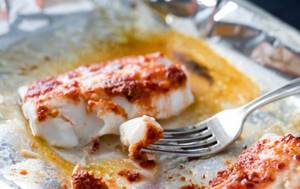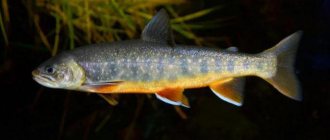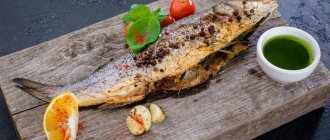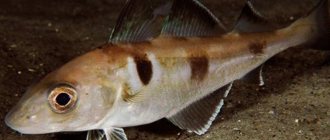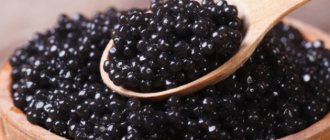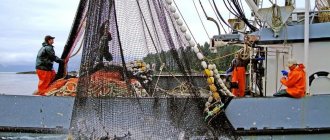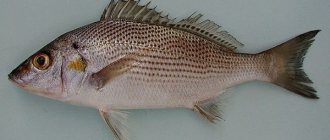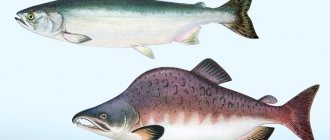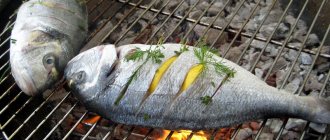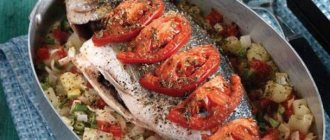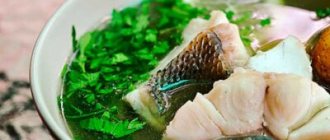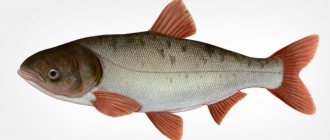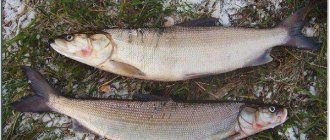What kind of fish
Haddock is a fish of the cod family. It lives in the salty waters of the Arctic and Atlantic oceans. This is not a river, but a marine representative of aquatic fauna. The largest numbers are observed in the North, Barents and Norwegian Seas. There is information that it can also be found in the Black Sea, but scientists say it is a representative of the genus of whiting.
Haddock has an elongated silver body with a black stripe and dark spots along the body. The British call it St. Peter's fish, whose fingerprints are left on its sides.
Industrial catch
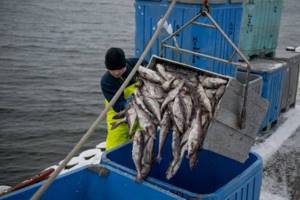
Lives in a school, feeds on crustaceans, worms, and mollusks. Mature individuals have a length of 50-75 cm, an average weight of 2-3 kg. It is curious that the rate of maturation is affected by the habitat; for example, in the North Sea, fish grow twice as fast as in the Barents Sea.
Spawning lasts from April to June. The instinct of reproduction encourages the fish to migrate to the warmer waters of the Norwegian Sea to the shores of the Lofoten Islands. One female lays from 170 thousand to 1.84 million eggs, but only a few of them will survive.
Despite the fact that haddock has been given the status of a protected species by the International Union for the Conservation of Animals, people continue to catch it en masse.
Bony or not
Despite the fact that there is debate about whether haddock is a sea or river fish, it should be taken into account that it belongs to the cod species, which are distinguished by a small number of small bones, as can be seen by looking at the photo.
They are so small in size that they soften and crush even more during heat treatment (especially by baking). This advantageous feature allows you to prepare a variety of dishes from haddock, from soups to canning, smoking, and steaming.
Haddock is versatile, and its meat, like cod, retains its elasticity even after processing. It has practically no scales. The description of the fish says that most of it is covered with mucus on the outside. Therefore, it is enough just to rinse the carcasses well under running water, after gutting them.
Fish fillets make tender cutlets, and steaming helps preserve the benefits of its composition. Haddock makes the most delicate pates, and pieces of its meat harmonize with other ingredients in salads, including warm types. Thanks to the delicate structure of the fillet, it will be an excellent filling for fish pies and pies.
Smoked or salted haddock is rarely sold commercially, but it can be prepared this way at home.
Beneficial properties for the human body
- Enriches the body with proteins, fats, vitamins and microelements.
- Product for a balanced diet.
- Reduces bad cholesterol levels.
- Activates mental processes.
- Positively affects mental state.
- Improves the functioning of the cardiovascular system.
- Natural source of vitamin D.
- Reduces the risk of developing diabetes, rheumatoid arthritis, multiple sclerosis.
- Supports visual acuity.
- Helps you look younger.
How to use when losing weight
The low calorie content and high protein content of haddock allows it to be included in the diet of people watching their weight and on a diet. Fish has the ability to dissolve excess cholesterol in the blood and strengthen the cardiovascular system.
Haddock should not be consumed as a mono-diet, because it does not contain the entire spectrum of necessary substances. It is necessary to combine fish with other dietary products for a balanced diet.

KBJU per 100 g depending on the method of preparation of the product:
For children
Haddock is a low-fat fish, so it is useful for children of any age. It is with this that you can start fish feeding for infants from 9-10 months.
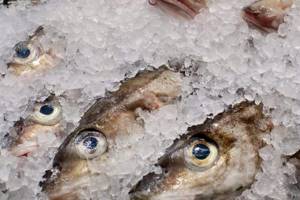
Beneficial properties for a growing child's body:
- promotes normal growth and development;
- strengthens immune defense;
- improves hand-eye coordination;
- supports intellectual processes - memory, attention, thinking and imagination;
- helps normalize sleep and wakefulness phases;
- strengthens bones and teeth, which is especially useful during growth spurts.
According to research, the body’s digestibility of protein from haddock and other fish is 93-98%, meat protein is 88%, so it is easier for a child to digest it.
Recommendations from nutritionists for losing weight
In the absence of contraindications, nutritionists advise including seafood in the diet of a person losing weight. In this case, the beneficial low-calorie properties identified in haddock allow us to recommend it as a dietary product.
The calorie content of this fish varies from 87 to 230 kcal per 100 grams of fillet. For those who want to lose weight, it is best to cook and bake haddock without oil. And adding fiber in the form of a vegetable salad will make the diet balanced according to KBJU.
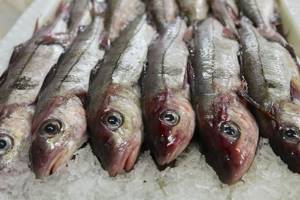
Features of nutrition and habits of haddock
The fish leads a schooling lifestyle and prefers to constantly remain in the bottom layers. Young individuals up to 1-1.5 years old stay in the middle depths (20-70 meters), which are abundant in small and nutritious food. Having gained 300-500 g of weight and reaching a length of 15-20 cm, they gradually press down to the bottom at 100-300 m with less risk of being eaten by halibut, sea bass, related species (cod, pollock) or other large predators.
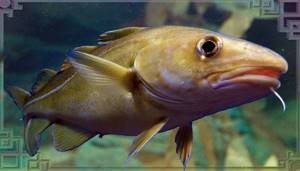
The main nutritional features of haddock include its omnivorous nature. The diet includes;
- zooplankton and benthos;
- bivalves and crustaceans;
- echinoderms and worms;
- caviar and small fish of other fish (herring, capelin, goby).
To learn more:
Seasonal fishing for predatory navaga
In search of food, the fish constantly makes vertical movements, examining the middle and surface layers, and also practices long-distance feeding migrations to the coasts of Norway and Iceland, where the main spawning grounds for cod are located.
Features of use for diseases
Haddock is a good source of nutrients for various diseases. The main thing is to prepare it correctly and eat it no more than 2-3 times a week.
- If you have coronary heart disease, you can eat haddock boiled and baked without fat. Sometimes you can add a small amount of coconut, corn, or flaxseed oil to it. Preference should be given to fillets; caviar should be limited.
- For pancreatitis, doctors recommend boiling, steaming in the form of a whole piece or cutlets. Fish soup is contraindicated as it contains extractive substances that irritate the gastrointestinal tract. Fried, smoked, and canned fish are prohibited for patients with pancreatitis.
- According to the glycemic index and calorie content, it is suitable for nutrition for type 1 and type 2 diabetes mellitus. Preference is given to boiled, stewed fish, as well as cooked in the oven or slow cooker. This product allows you to avoid surges in blood glucose and saturate the body with useful substances.
Haddock fish: description

This representative is not impressive in size and is smaller than cod. As a rule, the average size of individuals is about 50 cm, although a specimen a little more than 1 meter long has been caught. The average weight of individuals is also not large and is no more than 2 kg. Moreover, the weight of the fish depends on many factors, such as the age of the fish, its sex, the nature of the habitat and the availability of food supply.
Haddock is distinguished by the presence of 3 dorsal fins and 2 anal fins. The lower jaw is shorter than the upper jaw and there are no palatal teeth on the upper jaw. Space can be seen between all the fins, indicating a clear separation. The first anal fin is slightly larger than the second. The body of the fish is light in color.
Appearance

Haddock has some similarities with cod, as it has a small mouth, a pointed snout, a slender body, and a concave tail. Haddock is a typical predator that feeds on food items of animal origin. In addition, it has two anal fins, 3 dorsal and one chin. Moreover, the first dorsal fin is significantly higher than that of cod. On the sides of the body you can see light stripes, and the whole body is covered with dark spots. In haddock, the caudal fin is distinguished by a noticeable depression, and the second and third fins are more angular.
Interesting fact! The head and back of the haddock are purple-gray, while the sides are silvery-gray, with a distinct lateral line. The belly is always light. Haddock is easily recognized by the presence of black spotting present above the pectoral fin. Dark spots also appear on the sides of the body. Externally, haddock and cod are very similar.
Haddock has a smaller mouth than cod and a sharper snout, as well as a slimmer body. When viewed from below, the haddock's muzzle is straight and slightly rounded, and its nose is wedge-shaped. The upper jaw is slightly longer than the lower jaw, and the body is slightly flattened laterally.
The body is covered with fairly small scales, but with a thick layer of mucus. If you look at a haddock from above, you can see that this part of the body is distinguished by a dark purple-gray hue. The belly, lower sides and head are white. The fins have dark gray tones, and numerous black spots can be seen on the lower part of the sides.
Lifestyle, behavior

Haddock prefers to inhabit deeper water areas compared to cod, while it practically does not appear in shallow water areas. Despite the fact that haddock is a cold-blooded fish, it does not like very low temperatures. Therefore, the fish tries to leave Newfoundland, the Gulf of St. Lawrence and the territorial waters of Scotland when the water temperature drops to a critical level.
Haddock fish prefers to be at depths of up to 150 meters, adhering to the coastline at a distance of about 300 meters. Adults try to stay at depth, while juveniles prefer the upper layers of water.
The optimal temperature for haddock is from 2 to 10 degrees. The main population of haddock is dispersed in the cold and not very salty waters that are typical for the American coast of the Atlantic Ocean.
Motovsky Bay haddock
How long does haddock live?
Juvenile haddocks live in the coastal zone in shallow areas until they have enough strength and energy to go to open waters. Female haddocks become sexually mature at the age of 1 to 4 years, while males mature somewhat earlier.
Interesting to know! In the natural environment, haddock can live more than 10 years. It is believed that the fish is long-lived, especially since the average life expectancy is about 15 years.
Habitats

Haddock is a cold-loving fish, so its habitat extends to the northern waters of the Atlantic, with the most numerous populations located on the American coast. During the winter, haddock migrate south in large schools toward New York and New Jersey, and the fish have been spotted within Cape Hatteras. In the southern regions, there is but little haddock fishing along the Gulf of St. Lawrence, as well as along its northern coast. At the same time, haddock does not appear in the cold waters of the outer coast of Labrador, but here haddock pleases with its catches in the summer.
Diet
The basis of the diet, especially for juveniles, is made up of small invertebrates, while older and larger individuals prey on smaller fish of other species. After birth, the juveniles feed on zooplankton for the first few months, but then they become quite voracious predators, feeding abundantly on all varieties of invertebrates.
If we give a complete list of living food items, it will be very extensive and include almost all living creatures that live both in the water column and at the bottom of reservoirs. Haddock also preys on squid, as well as herring, especially off the coast of Norway, and within Cape Breton, haddock preys on young eels.
Reproduction and offspring

Having reached sexual maturity, which is possible at the age of about 4 years, males, as a rule, prefer to be in the depths, while females, on the contrary, prefer to stay in shallow water. The spawning process takes place at depths of up to 150 meters, from January to June. In this case, the peak of spawning occurs in March and April.
Interesting fact! As a rule, natural spawning grounds are located in the waters of central Norway, within the southwestern part of Iceland and Georges Bank. During the spawning period, the female lays up to 850 thousand eggs.
It is believed that older and larger females are capable of laying almost 3 million eggs. Fertilized eggs are located in the water column and migrate under the influence of the current. This process continues until the haddock fry emerge from the eggs. After birth, the fry spend several months almost at the surface of the water.
After this, they will sink closer to the bottom, where they will remain there almost all their lives, occasionally rising to the upper layers of the water. The mating season takes place in smaller areas throughout almost the entire spring.
Natural enemies
Haddock prefers to lead a gregarious lifestyle, so it always moves in large groups. The fish moves quite quickly, especially in case of danger. Haddock does not like to migrate long distances. Despite such impressive speed data, haddock has quite a lot of natural enemies.
Catching Black Sea haddock, fish stocking 05/08/2016
Population and species status
Haddock is a marine fish that inhabits the northern waters of the Atlantic Ocean and belongs to the cod family. Prefers to lead a bottom-dwelling and schooling lifestyle. It is of great commercial importance, as it is included in the human diet. Therefore, the demand for this fish is constantly increasing, which leads to its uncontrolled fishing and a decrease in numbers.
Over the past 2 years, conservation authorities have managed to do a lot of work to stop further decline in the population. Thanks to the established strict fishing rules, it was possible to restore the haddock population, but not enough to completely relax, since it still remains quite vulnerable. A 2017 assessment from the Georgia Haddock Association found that the fish was not being uncontrolledly harvested.
Commercial value

Haddock plays a very important role in human life and is therefore of great economic importance. For the British this is the most popular type of fish. In recent years, commercial fishing in North America has decreased, and noticeably, but today everything is falling into place. Haddock is an excellent food product for humans, both fresh, smoked, dried or canned, and in the form of various dishes. Haddock, compared to cod, is less healthy, so it was not in such great demand before. Due to the expansion of the global fish trade, haddock is in great demand as it is recognized by consumers.
The promotion of haddock on the world market was carried out due to modern technologies, or rather after more modern technologies for filleting and packaging both fresh and frozen fish appeared. Thanks to this, it was possible to increase the demand for haddock, which led to an increase in haddock catches.
To catch haddock, it is better to use natural bait, as it is the most effective. Haddock can be caught very well if you use shrimp and clams as bait. Alternatively, it is permissible to use pieces of fish or pieces of squid. At the same time, fish are also caught using artificial baits, but not as actively.
Interesting to know! As a rule, fish move in numerous schools, albeit at considerable depth, so you need to choose reliable equipment for fishing. At the same time, you need to remember that fish have rather delicate lips, therefore, with excessive efforts, the lips are torn, which leads to the fish disappearing.
Considering the fact that the fish prefers to be at depth, it is better to have a boat to catch it, since catching this fish from the shore is quite problematic.
To catch this fish, you will have to go to waters located in the northeast of England, as well as in the northwest of Scotland. In these areas, cod and whiting are much more common than haddock, so it is likely that more cod and whiting will be caught than haddock.
Chemical composition and calorie content
Averaged data on chemical composition and calorie content were taken from the official website of the US Agricultural Research Service.
Chemical composition of haddock fillet per 100 g:
- water – 83 g;
- proteins – 16 g;
- nitrogen – 2.6 g;
- fats – 0.45 g (cholesterol – 54 mg);
- carbohydrates – 0;
- microelements: Ca – 11 mg, Fe – 0.17 mg, Mg – 21.1 mg, P – 227 mg, K – 286 mg, Na – 213 mg, Zn – 0.32 mg, Cu – 0.021 mg, Mn – 0.011 mg, I – 150 µg, Se – 25.9 µg;
- vitamins: thiamine - 0.02 mg, riboflavin - 0.057 mg, niacin - 3.36 mg, pantothenic acid - 0.403 mg, vitamin B-6 - 0.281 mg, B-12 - 1.83 mcg, A - 17 mcg, E – 0.45 mg, D – 0.5 µg, K – 0.1 µg.
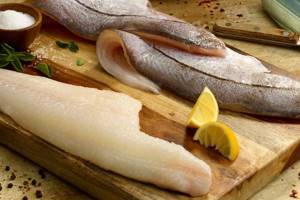
The protein composition is represented by various amino acids:
- essential – tryptophan, threonine, isoleucine, leucine, lysine, methionine, cysteine, phenylalanine, tyrosine, valine;
- replaceable - arginine, histidine, alanine, glycine, proline, serine, aspartic and glutamic acids.
Fatty acid content: saturated – 0.091 g, monounsaturated – 0.061 g, polyunsaturated – 0.166 g.
The amount of calories depends on the habitat of the fish. Thus, raw wild haddock has a calorie content of 80-88 kcal/100g, and farmed haddock has a calorie content of 72-73 kcal/100g.
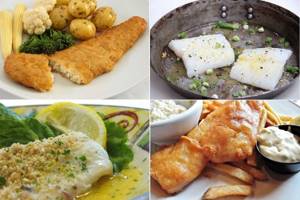
The cooking method also affects the amount of kcal/100g:
- boiled – 87-93;
- baked without adding oil – 94;
- fried without oil – 142;
- in batter – 195-230.
Nutritional value
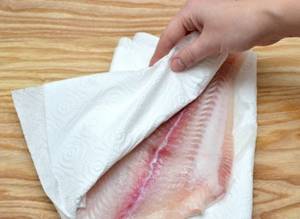
If you are looking for fish with a rich nutritional composition, haddock will satisfy your needs. Its fillet is the perfect combination of a large amount of protein and a small portion of fat. 100 grams of fresh fillet contains 76 kcal, 17.5 grams of protein and less than 1 gram of fat (the rest of the fat is concentrated in the liver of the fish, which can sometimes make up almost half of the total weight of haddock). In addition, this fish contains carbohydrates, vitamins, and minerals in proportions necessary to maintain the healthy functioning of the body. Haddock is rich in polyunsaturated fatty acids - substances that are extremely important for humans, which our bodies are not able to produce on their own.
As already mentioned, haddock is rich in vitamins, which affect the condition of the entire body. Thus, vitamin A, as an antioxidant, protects against free radicals and prevents eye diseases. B vitamins regenerate cells and tissues and are responsible for healthy hair and skin. It is extremely important that the group of B vitamins in this fish is also represented by the B12 component, which is present exclusively in products of animal origin, but is indispensable for humans. This vitamin is important for the proper functioning of the nervous system and healthy brain function. Sufficient consumption of B12 is the key to the absence of anemia. And vitamin D, also found in fish, will help maintain the strength of bones and teeth.
The mineral composition of haddock fillet is no less rich. In this product, scientists found sodium - good for muscles, phosphorus - important for the proper functioning of the kidneys, magnesium and calcium, which have a beneficial effect on the condition of bone tissue, and selenium - a powerful antioxidant that prevents cell mutations.
Protein from fish is a source of essential amino acids that our body is not able to produce on its own, but without which it cannot function properly.
Amino acids should be supplied to the body through foods rich in proteins. These substances affect the growth and development of muscle tissue and accelerate metabolism. And one more interesting note: the proteins contained in haddock fillets are more easily absorbed by the body than proteins from meat. Nutritional value per 100 g
| Calorie content | 76 kcal |
| Squirrels | 17.5 g |
| Fats | 0.6 g |
| Carbohydrates | 0 g |
| Vitamin A | 57 IU |
| Vitamin E | 0.4 mg |
| Vitamin D | 23 IU |
| Vitamin B3 | 3.8 mg |
| Vitamin B6 | 0.3 mg |
| Vitamin B9 | 12 IU |
| Vitamin B12 | 1.2 mg |
| Sodium | 260 mg |
| Potassium | 311 mg |
| Calcium | 22 mg |
| Phosphorus | 188 mg |
| Magnesium | 39 mg |
| Iron | 1.1 mg |
| Zinc | 0.4 mg |
Which is better haddock, cod or pollock?
All three species of fish belong to the cod family. They are almost identical in composition, but cod is fattier (fat content 8%) than haddock and pollock (<4%).

As for taste, haddock is not inferior to cod, and in comparison with pollock, it has more tender and juicy meat.
According to US tests, the advantage of haddock is its high iodine content and lower infection with helminths.
All the fish presented above, like other cod representatives, are not bony.
Where do they catch haddock?
Recreational and sport cod fishing is widely practiced along the northeastern borders of Russia. In the Baltic and the White Sea coast, preference is given to local subspecies of Atlantic cod; in the Barents Sea, haddock is caught, for example, at Cape Kanin Nos (Nenets Autonomous Okrug) or Nemetsky (Murmansk Region). This activity is popular in Norway, Canada, Scotland, Ireland, and Iceland, where fish migrate for food from the North Sea, which does not wash the territory of Russia.
To learn more:
Halibut: types of fish, differences and lifestyle features
To catch haddock, you don’t need to move very far from the shore, just sail on a boat (boat) at 500-2000 m and find a place with moderate depths. Fishing is good in the morning and evening. The frequency of bites is favorably influenced by the presence of tide.
How to choose and store correctly
In the store, haddock carcasses can be purchased chilled, frozen, or salted, with or without the head. To buy a good copy, you need to pay attention to the following points:
- Smell. It should be marine for chilled fish and neutral for frozen fish.
- Eyes. Transparent, without turbidity. This sign indicates freshness.
- Gills. Normally pink with a reddish tint. Mucous coating, darkening, grayness, spots are a sign of stale goods.
- Ice crust. It should be uniform, without cracks or leaking blood.
- Carcass pose. Natural straight. Curvature indicates re-defrosting.
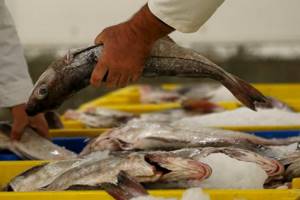
Haddock is a perishable product, so the cleaned carcass should be cooked or frozen immediately. The shelf life at a temperature of – 18℃ is 6 months.
Composition of haddock
The composition includes the following vitamins (per 100 g of weight):
- vitamin PP – 6 mg;
- vitamin C – 0.8 mg;
- vitamin E – 0.3 mg;
- vitamin B2 – 0.3 mg.
In addition, fish contains retinol (10 mcg) and niacin (up to 3 mg).
The microelement composition of 100 g of haddock is as follows:
- phosphorus – 180 mg;
- potassium – 300 mg;
- magnesium – 35 mg;
- iodine – 150 mcg (fully covers the daily requirement, the maximum concentration among all fish);
- chromium – 55 mcg (10% more than the daily value);
- cobalt – 20 mcg (double daily value);
- copper – 230 mcg;
- fluoride – 500 mcg.
The microelement composition of the product is very interesting: despite the relative scarcity of almost all components, three of them completely cover the body’s daily needs.
What products does it combine with?
Haddock meat consists of proteins and, to a lesser extent, fats, so it is not advisable to combine it with carbohydrates. This leads to stagnation of carbohydrate foods, fermentation, and bloating.
And also should not be consumed with fatty foods, as fats inhibit the secretion of gastric juice.
Fish protein will not be digested and may stagnate, which is manifested by pain and heaviness in the stomach. Compatibility table with other products
| Fine | Ghee, whey, greens, cabbage, carrots, beets, pickles, green vegetables |
| Acceptable | Rice, buckwheat, lemon, quinoa, tomatoes, butter, vegetable oil, pumpkin, eggplant, zucchini |
| Badly | Meat, poultry, eggs, mushrooms, cream, sour cream, lard, nuts, seeds, potatoes, dairy products, cheeses, feta cheese, wheat, rye, oats, bread, peas, chickpeas, mung beans, beans, beans, lentils, |
Cooking secrets
Recipe No. 1 Haddock in tomato with onions and carrots
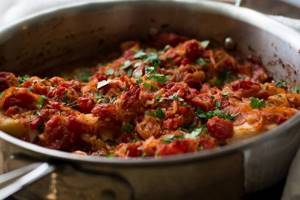
Ingredients:
- fish fillet – up to 1 kg;
- carrots – 2-3 pcs.;
- onions – 2 pcs. (average);
- tomato juice or paste – up to 200 ml;
- vegetable oil for frying;
- spices - salt, sugar, pepper, seasoning for fish.
Preparation:
- Peel and chop the vegetables. Fry in vegetable oil until soft.
- Add the tomato, a pinch of salt, sugar and simmer over low heat for about 5 minutes.
- Cut the thawed haddock fillet into 4-6 cm pieces.
- Place the fish on a vegetable fryer. Season to taste. Add water to cover the pieces. After boiling, the fish should be simmered over low heat for 30-45 minutes.
Recipe No. 2 Haddock cutlets
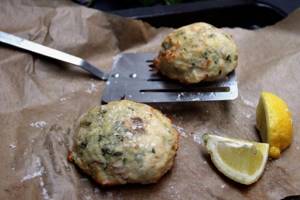
For the dish you will need:
- haddock meat – 1 kg;
- onions – 2 pcs. (average);
- garlic – 2 cloves;
- egg – 2 pcs.;
- bread (delicious with white) – 2 large slices;
- milk for soaking bread;
- flour – 2/3 cup;
- vegetable oil for frying;
- spices - salt and pepper.
Preparation:
- Grind fish meat and vegetables in a meat grinder. Soak the bread in milk.
- Add milk-squeezed bread, eggs, and seasonings to the resulting minced meat. Stir and beat to saturate the muscle fibers with liquid.
- Form cutlets, roll them in flour and fry in vegetable oil until cooked, 7-10 minutes on each side.
In the photo you can see what the finished fish cutlets look like. Fried foods are harmful for certain categories of people; in this case, it is recommended to steam them.
Features of haddock
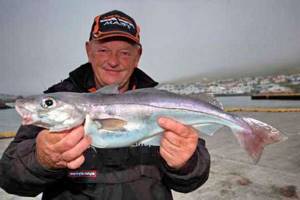
This is a marine fish that lives mainly in the waters of the North Atlantic, as well as in the Barents Sea.
Haddock can grow up to 1 meter in length and gain weight up to 15 kilograms. However, the average size of haddock is up to 50 cm in length and weighs from 3 to 5 kilograms.
It belongs to the cod fish species, so there is a certain similarity. This is indicated by oval spots located on the sides of the fish. Haddock meat is characterized as white and dense, retaining its elasticity during heat treatment.
Haddock meat goes well with many spices and products, so various dishes are prepared from it, including restaurant ones. It can be consumed fresh, smoked and dried. But, mostly, it is found fresh frozen on the market. Haddock is especially tasty if you pickle it fresh.
Benefits of haddock

Many people prefer to buy and eat fish meat because it is much healthier than other meat of animal origin. Fish meat contains a sufficient amount of vitamins and microelements that have a positive effect on the human body. Fish is well digestible due to the fact that it does not contain a protein called elastin.
Smoked and dried haddock
Fish in this form is rarely found on store shelves. It is low-fat, so after smoking or drying it becomes quite dry. But this is a matter of taste!
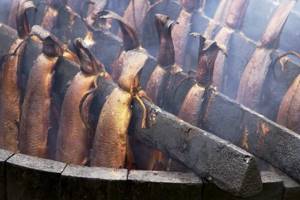
This is how they smoke it in Scotland
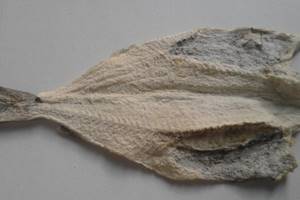
Dried haddock
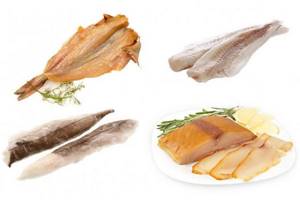
It should be remembered that smoked and dried salted fish are not allowed for people with pathologies of the digestive tract, urinary and cardiovascular systems.
Methods of preparing fish. Baking
As we already wrote above, fish can be fried, boiled, salted, or steamed. However, one of the most delicious recipes for haddock fish dishes is baking. Fish prepared in this way has a delicate and mild taste that goes well with various spices and vegetables, as well as sweet, sour and hot sauces.
The following components will be useful for preparation:
- haddock fillet – 1 pc.;
- onion – 1 pc.;
- lemon – 1 pc.;
- seasonings - to taste.
To get a delicious baked haddock fish, first, you need to prepare the fillet. To do this, it should be peeled and cut into small pieces. Then the fish needs to be salted, peppered and sprinkled with lemon juice.
The foil on which baking will take place should be greased with vegetable or olive oil. Chop the onion into half rings and place next to the prepared fillet. Bake the fish in a preheated oven for half an hour at a temperature of 180 ºC.
